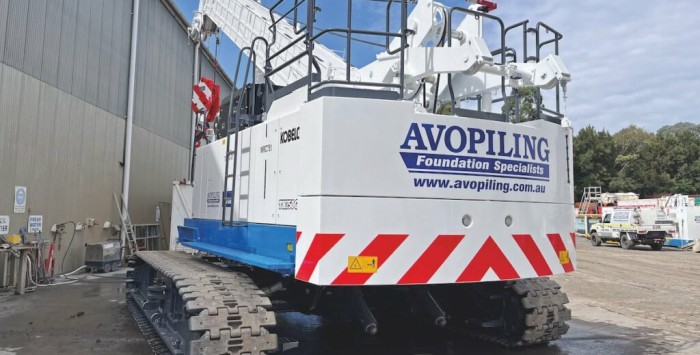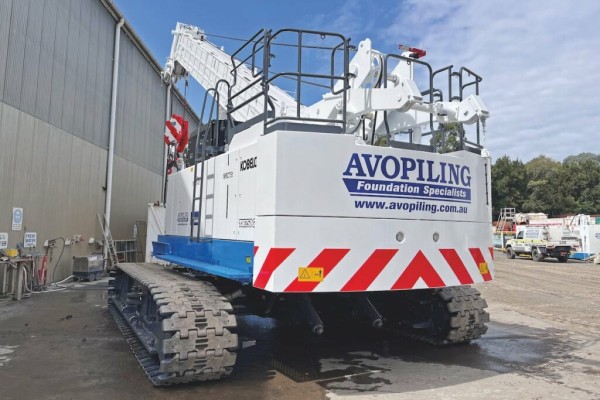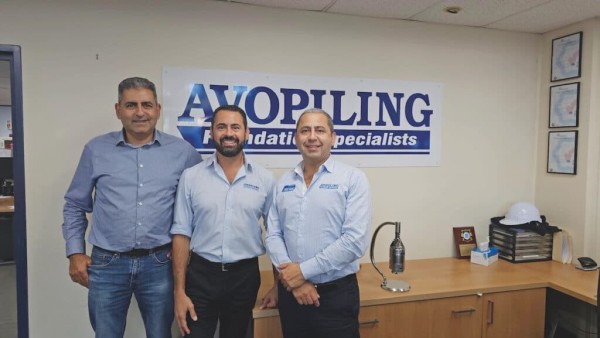Avopiling’s continued investment in Kobelco and TRT
10 July 2024
Leading piling and foundation specialist Avopiling recently took delivery of four new 75-tonne capacity Kobelco telescopic crawlers. Avopiling’s Group General Manager David Tevanian explains more.
“The process of renewing and expanding the capabilities of our crane fleet started two years ago and initially we invested in the larger capacity Kobleco lattice boom crawlers,” said David.
The initial order was delivered by TRT in mid 2022 and included the Kobelco CKE 900, which has a 100t capacity with a maximum boom length of 61m, and two Kobelco CKE 1100s, which feature a lifting capacity of 110t and a boom length of 70.1m. Then there is a Kobelco CKE 1350, which features a lifting capacity of 150t and a boom length of 76.2m and two Kobelco CKE 2500s, with a lifting capacity of 250t and boom lengths of 91.4m.
“I also wanted to ensure that the fleet has plenty of capabilities in lower capacity cranes and I was waiting for the Kobelco to release the TK750s, a 75 tonne capacity telescopic crawler, to the overseas markets. Following a tour of the factory in Japan, I was aware that Kobelco had done a lot with the domestic market, but they hadn’t pushed this particular model overseas.
“Finally, TRT was able to confirm pricing, delivery scope and timing, and as soon as we had this information, we quickly pushed the button on four units because we are increasingly using this capacity and type of crane in our works,” said David.
He goes on to explain how versatile the Kobelco TK750 is and how it works with the mobilisation of the larger capacity cranes.
“To have a 75t capacity tele crawler turn up to site and be lifting in under an hour is the reason we’ve gone down this path. We took delivery of the larger lattice boom cranes, including the CKE 1350 and the CKE 2500 and they are coming to site with the tracks and counterweights off, as is the larger piling equipment.
“Our thought process was to have the smaller capacity units in the fleet which we are able to set up very quickly, unload semis, and start the build with the larger cranes and piling equipment, which greatly compresses our mobilisation times.
“When the mobilisation of the larger crane and piling equipment is complete, the TK750s are demobilised and floated to the next project. Or if you’ve got capacity, you leave it on the project, and keep it working as a support crane.
“Again, it’s about the progression and evolution of our business and the modernisation of our fleet. Our Sumitomo SC500 and Sumitomo SC700, for example, are hitting 25 years and with all the maintenance engineering and ensuring the 10 year major inspections are up to date, it is getting increasingly expensive getting them to site.
“The Kobelcos have been a really good purchase, and the guys are really happy to have them in the fleet. I jumped in one of the TK750s the other day, and it was really smooth and responsive to operate, I sometimes wish I could spend more time operating the cranes,” said David.

The Kobelco telescopic crawler features a maximum lifting capacity of 75t at 3m and has a telescopic boom length of 10m to 30.1m, with a main hook maximum height of 30.4m. Image: Avopiling.
“We went with the shorter 30 metre booms on these TK750s as opposed to the long boom, which offers an extra six metres, because we wanted a larger line pull on these units. They offer over 11t of line pull which is excellent for the topping-and-tailing and you don’t get caught out with not having the capacity to be able to roll these cages up in the piling work,” he said.
The Kobelco TK750 75t capacity crawler is equipped with a Daimler 235kW diesel engine to provide the rugged power for the piling, foundation and civil work.
The TK750 has 208kN maximum line pull and 107.9kN-rated line pull on the main, auxiliary and third winch, and an operating weight of 74.8t. It also features 153kN maximum line pull and 68.7kN-rated line pull on the main and auxiliary winch, and an operating weight of 69.2 tonnes.
The telescopic crawler features a maximum lifting capacity of 75t at 3m and a telescopic boom length of 10m to 30.1m with a main hook maximum height of 30.4m.
The telescopic crawler cranes of the Kobelco TK750 Series combine the lifting power and high stability of crawler crane models with the excellent performance of an automatic boom extender/retractor.
David has been pleased with the service and support he has received from TRT Australia.
“Troy Hand and his team at TRT have been excellent to deal with. They are always there with support if there are any niggling issues with the Kobelcos. The service and support is also excellent with spare parts readily available,” he said.
David explains the types of the type of works and environments the Kobelco TK750s are suited for.
“For us the Kobelcos are working in piling work and for most of the time, the work is not pushing the crane to its capacity. We are using it for lifting ancillary equipment, drilling tools, casings and reinforcement cages.
“They are operating in tough environments, but they are not being used in a heavy-duty scenario, like our other cranes. We have Bauers and Liebherrs in our piling equipment fleet and they are specifically built for duty cycle works. They feature 25t, 30t and 35t winches, big line pull, big ropes and you are using them for grab work, driving tubes, or steel casings,” said David.
“The beauty of theseTK750s cranes is they come from Kobelco’s background in foundation equipment, and you can still run a vibrator, and that type of equipment on these cranes, which is fantastic for us. Now we have lots of capacity in the fleet which has made a big difference to the business.
“We are not spending money hiring in external cranes – we are managing our craneage requirement internally. It helps build our business and the profile of the business. When you drive past many of the major projects in the major cities you will see an Avopiling piling rig, in our colours, and you are also seeing an Avopiling branded crane in our colours, that’s something to be proud of,” he said.

Brothers Mario, David and Masis Tevanian. Image: Avopiling.
Avopiling was established in 1989 by David’s father Avo Tevanian (B.Tech Civil Engineer). Avo has 48 years of diverse experience in the field of piling, foundations and ground engineering.
“Recently, I was driving down to Gerringong with Dad, we were driving over the Fern Street Bridge and I told him we put in the piles for the project, 1,800 of them. Dad said that was great and he looks over, and 30 metres to our left is a rail bridge and he said, “Well, I did the piles for that bridge 20 years ago.” We are multi-generational business working on major projects that will service the community for generations to come and we are very proud of the legacy we are leaving,” said David.
David is one of three brothers and all now work in the business
“I’m the youngest of the three brothers. My middle brother Masis has been working in the business for 25 years and my older brother Mario has been working in the business full time for close to two years.
“Mario worked with Microsoft for 20 years, so his background is digital platforms and he’s working with us to digitise and modernise the business. Masis works on the operational side of the business and spends time setting up the projects with the right equipment and specifically the drilling tools.
“Dad is slowly stepping aside and handing over more and more of the business for us to run. I’ve been the General Manager for three years now and I personally believe you have to be in a position for five years before you can really stand on your own two feet and really understand what the role entails.
“I had a steep learning curve during COVID-19 which proved to be a really difficult time for the business, but we’ve managed to pull out of that, and we grew from 130 people to 250 in a period of 13 months,” he said.
TRT is the Oceania agents for Kobelco providing a full comprehensive end to end solution, as well as service and parts support 24/7, 365 days a year during the entire life of a crane.
